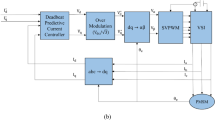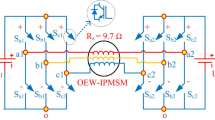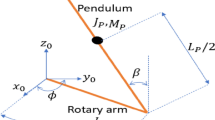Abstract
This paper presents a modern approach for speed control of an induction motor (IM) using the particle swarm optimization (PSO) method for determining the optimal parameters, K p and K i , of the integral proportional (IP) controller. The use of PSO as an optimization algorithm makes the drive robust, with faster dynamic response, higher accuracy and insensitive to load variation. Comparison between different controllers is achieved, using an IP controller which is tuned by two methods, firstly manually and secondly using the PSO technique. Integral time absolute error, integral absolute error and integral square error performance indices are considered to satisfy the required criteria in output speed of an IM. From the simulation results it is observed that the IP controller designed with PSO yields better results when compared to the traditional method in terms of performance index.









Similar content being viewed by others
References
Ali AB, Khedher A, Mimouni MF, Dhifaoui R (2009) Torque maximization and sensorless control of induction motor in a flux weakening region. Int J Sci Tech Autom Control Comput Eng IJ-STA 3(1):972–985
Allaoua B, Gasbaoui B, Mebarki B (2009) Setting up PID DC motor speed control alteration parameters using particle swarm optimization strategy. Leonardo Electron J Pract Technol (14):19–32
Bekakra Y, Ben Attous D (2014) Optimal tuning of PI controller using PSO optimization for indirect power control for DFIG based wind turbine with MPPT. Int J Syst Assur Eng Manag 5(3):219–229
Bousserhane IK, Hazzab A, Rahli M, Mazari B, Kamli M (2006) Position control of linear induction motor using an adaptive fuzzy integral—backstepping controller. Serbian J Electr Eng 3(1):1–17
Chaari A, Soltani M, Gossa M (2007) Comparative study between the conventional regulators and fuzzy logic controller: application on the induction machine. Int J Sci Tech Autom Control Comput Eng IJ-STA 1(2):196–212
Eberhart RC, Shi Y (2000) Comparing inertial weights and Constriction factor in particle Swarm optimization. In: Proceeding of the international congress on evaluationing computation, pp 84–88
Elwer AS (2006) A novel technique for tuning PI-controllers in induction motor drive systems for electric vehicle applications. J Power Electron 6(4):322–329
Kennedy J, Eberhart R (1995) Particle swarm optimization. In: Proceedings of IEEE international conference on neural networks, vol 4. Perth, WA, pp 1942-1948
Lalitha MP, Reddy CV, Usha V (2010) Optimal DG placement for minimum real power loss in radial distribution systems using PSO. J Theor Appl Inf Technol 13(2):107–116
Lin FJ, Teng LT, Lin JW, Chen SY (2009) Recurrent functional-link-based fuzzy-neural-network-controlled induction-generator system using improved particle swarm optimization. IEEE Trans Ind Electron 56(5):1557–1577
Mechernene A, Zerikat M, Hachlef M (2008) Fuzzy speed regulation for induction motor associated with field-oriented control. Int J Sci Tech Autom Control Comput Eng IJ-STA 2(2):804–817
Naka S, Genji T, Yura T, Fukuyama Y (2003) A hybrid particle swarm optimization for distribution state estimation. IEEE Trans Power Syst 18(1):60–68
Poli R, Kennedy J, Blackwell T (2007) Particle swarm optimization. Swarm Intell 1(1):33–57
Qiao W, Venayagamoorthy GK, Harley RG (2006) Design of optimal PI controllers for doubly fed induction generators driven by wind turbines using particle swarm optimization. In: IEEE 2006 international joint conference on neural networks, pp 1982–1987
Author information
Authors and Affiliations
Corresponding author
Appendices
Appendix A: Parameters
Rated values: 1.08 Kw; 220/380; 50 Hz; 2.83A/4.91 A, 1500 rpm.
Rated parameters: Rs = 10 Ω, Rr = 6.3 Ω, Ls = 0. 4642 H, Lr = 0. 4612 H, M = 0. 4212 H, P = 2.0, J = 0.01 kg m2, f = 0.00 N-m/rad.
Appendix B: Nomenclature
-
V sd , V sq i sd , i sq , ϕ rd and ϕ rq are stator voltage, stator current and rotor flux d-q components in the rotor flux oriented reference frame;
-
R s , R r are the stator and rotor resistances;
-
L s , L r , M are the stator, rotor and mutual inductances;
-
ω s , ω r , ω sl are the synchronous, rotor and slip speed in electrical;
-
T em , T l are the electromagnetic torque and the load torque respectively;
-
P is number of pole pairs;
-
J, f are the motor inertia and viscous friction coefficient respectively;
- IP:
-
Integral proportional;
- FOC:
-
Filed oriented control;
- PSO:
-
Particle swarm optimization;
- IM:
-
Induction motor.
Rights and permissions
About this article
Cite this article
Bekakra, Y., Ben Attous, D. Optimizing of IP speed controller using particle swarm optimization for FOC of an induction motor. Int J Syst Assur Eng Manag 8 (Suppl 1), 361–369 (2017). https://doi.org/10.1007/s13198-015-0391-1
Received:
Revised:
Published:
Issue Date:
DOI: https://doi.org/10.1007/s13198-015-0391-1




